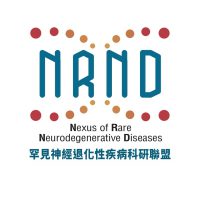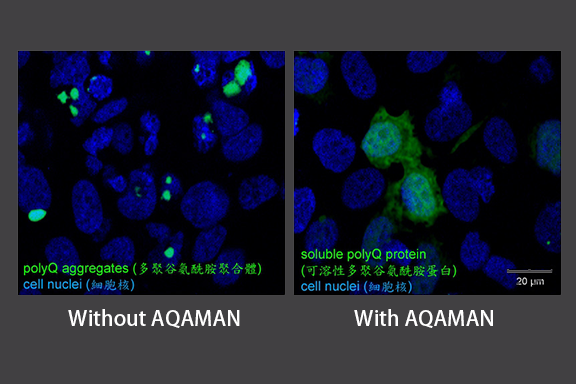The first step to the lengthy process of developing a new drug is the discovery of drug candidate – a compound that shows therapeutic potentials. The study of pathogenic mechanism of rare diseases at NRND have led to some major breakthroughs in understanding polyQ diseases, presenting great potential for developing drugs to restrain and treat degeneration.
Professor Chan and the international team of collaborators (Ho Yu Au-yeung, Maria Elena Regonesi, Steven C. Zimmerman) discovered a small molecule compound termed AQAMAN in 2019, which can potentially help patients of polyQ diseases, especially Machado-Joseph Disease, the most common form of spinocerebellar ataxias (SCAs).
Another promising discovery the novel drug candidate P3 (Edwin Chan, K.F. Lau, P.P. Li, Jacky Ngo, S. Peng, D.D. Rudnicki, H. Tsoi, Q. Zhang). P3 is a 13-amino acid peptide for poly-glutamine diseases, which include Huntington’s Disease and several types of spinocerebellar ataxias. P3 is the first inhibitor in the world that can potently mitigate neurodegeneration in these diseases through neutralising toxic RNA. In recognition of this achievement, the US Patent and Trademark Office has granted this technology a patent.
Apart from P3, BIND can also suppress neurodegeneration in diverse polyQ diseases as well as C9ALS/FTD. Professor Chan and his colleagues (Jonathan Choi, Knud Jensen, Jacky Ngo, Yi Wang, Joan Zuo) are endeavouring to improve the stability of BIND in order to bring the study to the pre-clinical stage soon.
The discovery of AQAMAN, P3 and BIND is a major step forward in the development of therapeutics of rare diseases at its early stage. Once other institutions or pharma companies show interest in bringing these drug candidates into the clinical stage, members of NRND is happy to guide them, as consultants, on the long process of clinical validation and approval.
Publications :
Aggregation for Machado-Joseph-Associated Neurodegeneration (AQAMAN):
Hong, H., Koon, A.C., Chen, Z.S., Wei, Y., An, Y., Li, W., Lau, M.H.Y., Lau, K.F., Ngo, J.C.K., Wong, C.H., Au-Yeung, H.Y., Zimmerman, S.C., Chan, H.Y.E.* (2019) AQAMAN, a bisamidine-based inhibitor of toxic protein inclusions in neurons, ameliorates cytotoxicity in polyglutamine disease models. J. Biol. Chem. 294, 2757-2770 (Featured on the cover of the issue)
P3:
Zhang, Q., Tsoi, H., Peng, S., Li, P.P., Lau, K.F., Rudnicki, D.D., Ngo, J.C. and Chan, H.Y.E.* (2016). Assessing a peptidylic inhibitor-based therapeutic approach that simultaneously suppresses polyglutamine RNA- and protein-mediated toxicities in patient cells and Drosophila. Dis. Model. Mech. 9, 321-34
Beta-structured inhibitor for neurodegenerative diseases (BIND):
Zhang, Q., Chan, Z.S., An, Y., Liu, H., Hou, Y., Li, W., Lau, K.F., Koon, A.C., Ngo, J.C.K.* and Chan, H.Y.E.* (2018). A peptidylic inhibitor for neutralizing expanded CAG RNA-induced nucleolar stress in polyglutamine diseases. RNA 24, 486-498.
Zhang, Q., An, Y., Chen, Z.S., Koon, A.C., Lau, K.F., Ngo, J.C.* and Chan, H.Y.E.* (2019) A peptidylic inhibitor for neutralizing r(GGGGCC)exp-associated neurodegeneration in C9ORF72-associated amyotrophic lateral sclerosis and frontotemporal dementia. Mol. Ther. Nucleic Acids 16, 172-185

